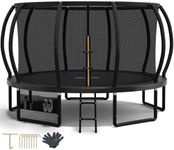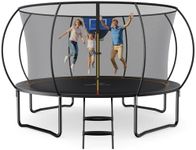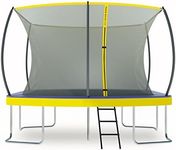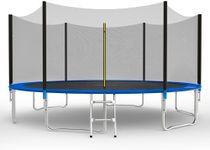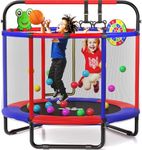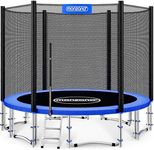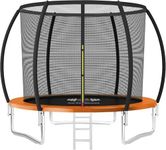Buying Guide for the Best Trampolines
Choosing the right trampoline can be a fun and rewarding experience, but it's important to consider several key factors to ensure you get the best fit for your needs. Trampolines come in various sizes, shapes, and with different features, so understanding what to look for can help you make an informed decision. Here are some key specifications to consider when shopping for a trampoline.SizeThe size of the trampoline is one of the most important factors to consider. Trampolines come in a range of sizes, typically measured in feet. Smaller trampolines (6-10 feet) are great for younger children or smaller yards, while medium-sized trampolines (10-14 feet) are suitable for older children and teens. Larger trampolines (14 feet and above) provide ample space for multiple users and are ideal for families with larger yards. Consider the available space in your yard and the age and number of users when choosing the size.
ShapeTrampolines come in various shapes, including round, rectangular, and oval. Round trampolines are the most common and are generally safer as they direct users towards the center. Rectangular trampolines offer a larger jumping area and are preferred by gymnasts and athletes for their even bounce. Oval trampolines provide a combination of the two, offering a larger jumping area while still directing users towards the center. Choose the shape based on the intended use and available space.
Weight LimitThe weight limit of a trampoline indicates the maximum weight it can safely support. This is crucial for safety and longevity of the trampoline. Trampolines with higher weight limits are more durable and can accommodate multiple users at once. For younger children, a lower weight limit may suffice, but for older children, teens, and adults, look for trampolines with higher weight limits to ensure safety and durability.
Safety FeaturesSafety features are essential when choosing a trampoline. Look for trampolines with safety nets, padded frames, and secure enclosures to prevent falls and injuries. Some trampolines also come with additional safety features like no-gap enclosures and reinforced stitching. Prioritize trampolines with comprehensive safety features, especially if the trampoline will be used by younger children.
Spring vs. SpringlessTrampolines can have traditional springs or be springless. Spring trampolines use metal springs to provide bounce, while springless trampolines use flexible rods or bands. Springless trampolines are generally considered safer as they eliminate the risk of getting caught in the springs, but they can be more expensive. Consider the safety and budget when deciding between spring and springless trampolines.
Durability and MaterialsThe durability of a trampoline is determined by the quality of materials used. Look for trampolines with rust-resistant frames, UV-resistant mats, and high-quality stitching. Durable trampolines will last longer and provide a safer jumping experience. If the trampoline will be exposed to the elements, prioritize weather-resistant materials to ensure longevity.
Assembly and MaintenanceConsider the ease of assembly and maintenance when choosing a trampoline. Some trampolines come with detailed instructions and require minimal tools for assembly, while others may be more complex. Additionally, consider the maintenance required to keep the trampoline in good condition, such as regular inspections and cleaning. Choose a trampoline that fits your comfort level with assembly and maintenance.
